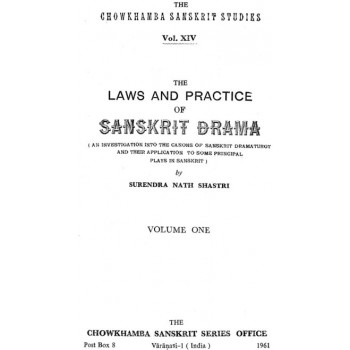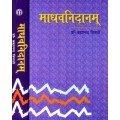The Laws and Practice of Sanskrit Drama
| Price: | Rs.250.00 |
Detail Of The Laws and Practice of Sanskrit Drama
| ISBN | DPB2642 |
| Pages | 602 |
| Language: | English |
| Size(in cm): | 9.0 inch x 5.5 inch cm |
| Weight(in grams): | 700(approx) |
Description:
About the Book
The Laws And Practice Of Sanskrit Drama. Volume one, by Dr. S. N. Shastri presents a comprehension study of the canons of Sanskrit dramaturgy enunciated by Bharata and his followers, It illustrates principles of dramatic criticism by citing popular examples from Sanskrit plays extant today; and makes available to modern scholars a comparative study of the essentials of appreciation of the mimetic art of ancient Hindus. It also "elucidates the development of critical standards of judgment in regard to the various patterns of Sanskrit plays evolved by canonists belonging to different ages and holding, divergent views. It attempts to interpret the notions of different canonists and critics in the light of the practice of master playwrights, arid mow an integrated study of the different schools of Sanskrit dramaturgy with a view', inculcating among modem readers a spirit of appreciating Sanskrit plays as dramatic compositions distinct from other specimens of Sanskrit poetry. The author’s insight into a valuable aspect of literary studies makes book a work of great scholarship.
Preface
The idea of this thesis developed from the fact that the of Dramaturgy discussed by the law-makers like Bharata, Dhananjaya, Ramacandra and Gunacandra, Sara- datanaya, Vidyanatha, Singa Bhupala, Visvanatha and Sagaranndin have not been so far fully analysed and compared in anyone ingle contribution. Mankad's Types of Sanskrit - Drama deals with mere definitions of the Rupakas- as given by the dramaturgists, and lays more stress on the Nrtta-plays, their species and evolution. Besides, no attempt is made there to apply these rules to any particular specimens and to examine the practice of the playwrights in this behalf. The other work dealing the subject is Kulkarni's Sanskrit Drama and Dramatist. which has dealt with later dramaturgists only. His method of application of these rules with regard to the Dramas is only in a summary form, e. g. in Kalidasa's Sakuntala he would not make mention of the type of the Prastavana, the requirements of Induction, the Junctural sub-divisions, the dramatic embellishments and so on. Of the modern histories of the Sanskrit literature the most important work dealing with the subject is SANSKRIT DRAMA by Dr. A. B. Keith. He has, no doubt, elaborated certain points like the age of the playwrights, their style and language, and given synopsis of the plays with some out- standing characteristics of the drama, but the aim of the present work is not only the elaboration but also a synthetic survey of the whole matter, which has not been so treated by Dr. Keith, The Table of Contents will show that an attempt is made here for the first time to take a synthetical view of the entire subject and to examine the application of the canons in a methodical way pointing out the omissions and- the new additions to the laws observed in the dramatic literature under review. Apart from this little originality, the analysis done here is expected to present a critical review of the dramaturgical laws and their general application from the very beginning of the Art until it became almost standardised by the master playwrights in Sanskrit.
The age of the dramaturgists and the playwrights is rather an intriguing point. This is not the main theme of this thesis to discuss in detail whether the dramatic laws could have developed in the absence of any dramatic literature. On the other hand, all well-established rules and methods followed and recognised by the earlier play- wrights became the laws of conduct for all subsequent writers. However, the historians have assigned the following dates to different dramaturgical works:
The date of Bhasa, as is recognised by all the historians, has to be put between the third century B. C. and the third century A. D. If the date of Bharata be accepted during the third century A. D., the plays of Bhasa must have developed without the guidance of Bharata. Whether there were any dramaturgists before the third century B. C. like Kohala, Krsasva, Matrgupta, Subandhu, Asmakutta, Nakhakutta and others is Dot quite certain; but in view of the fact that literature may develop independently of any law-books on Grammar, Poetics and Dramaturgy, the absence, of any dramaturgists does not preclude the probability of any regular and uniform development of a pattern by any particular author. Therefore even in the absence of any such laws, Bhasa could have, in a methodical and uniform manner, written his plays which present diverse patterns of dramatic art. So far as Kalidasa is concerned, if his time is taken to be the fifth Century A. D., it cannot be overlooked that he was guided to a large extent by the Natya-sastra of Bharata. This expectation is fulfilled to a great extent as is borne out by the elaborate examination of his plays done in Book II of the present work.
The consideration of the later dramaturgists after the time of Kalidasa is necessitated for the comparison of Bharata's Laws rather than the application of the later ones.
It is, for this reason, that the present work is divided into two parts: Book I, which is -the main theme, deals with a critical examination of the laws of Drama from the earliest time of Bharata to the latest development of different schools irrespective of their application to the works written by the earlier playwrights. Book II, Part I, deals with a detailed examination of a set of uniform laws as applied to the dramas of Kalidasa; and the second Part of the Book U proposes to examine the plays of Bhasa and predecessors of Kalidasa. The application to the works of later playwrights has to be deferred for the present, partly because of their close adherence' to the model adopted by the standard earlier authors and partly because the examination of all the existing dramas in a single book is impracticable. All the same, the application of the laws of dramas, though limited at present to the works of Kalidasa and Bhasa, amply testifies to the fact that their scheme has greatly influenced the later play- wrights in construction of their plays.
Charts appended hereto, it may be hoped, will facilitate a clearer grasp of the detailed ramifications of a stem than the pen-pictures attempted in the descriptive portion. A Thesaurus of the dramaturgical terms added as a fruitful appendix will show the different uses of the same term by the canonists in different context, which, otherwise, may have caused confusion in understanding the subject critically. A Glossary of Technical terms given as Appendix C will serve the average reader.
Reviews (0)
Write a review
Your Name:Your Review:
Note: HTML is not translated!
Rating: Bad Good
Enter the code in the box below:
Recently Viewed



 |
| 

